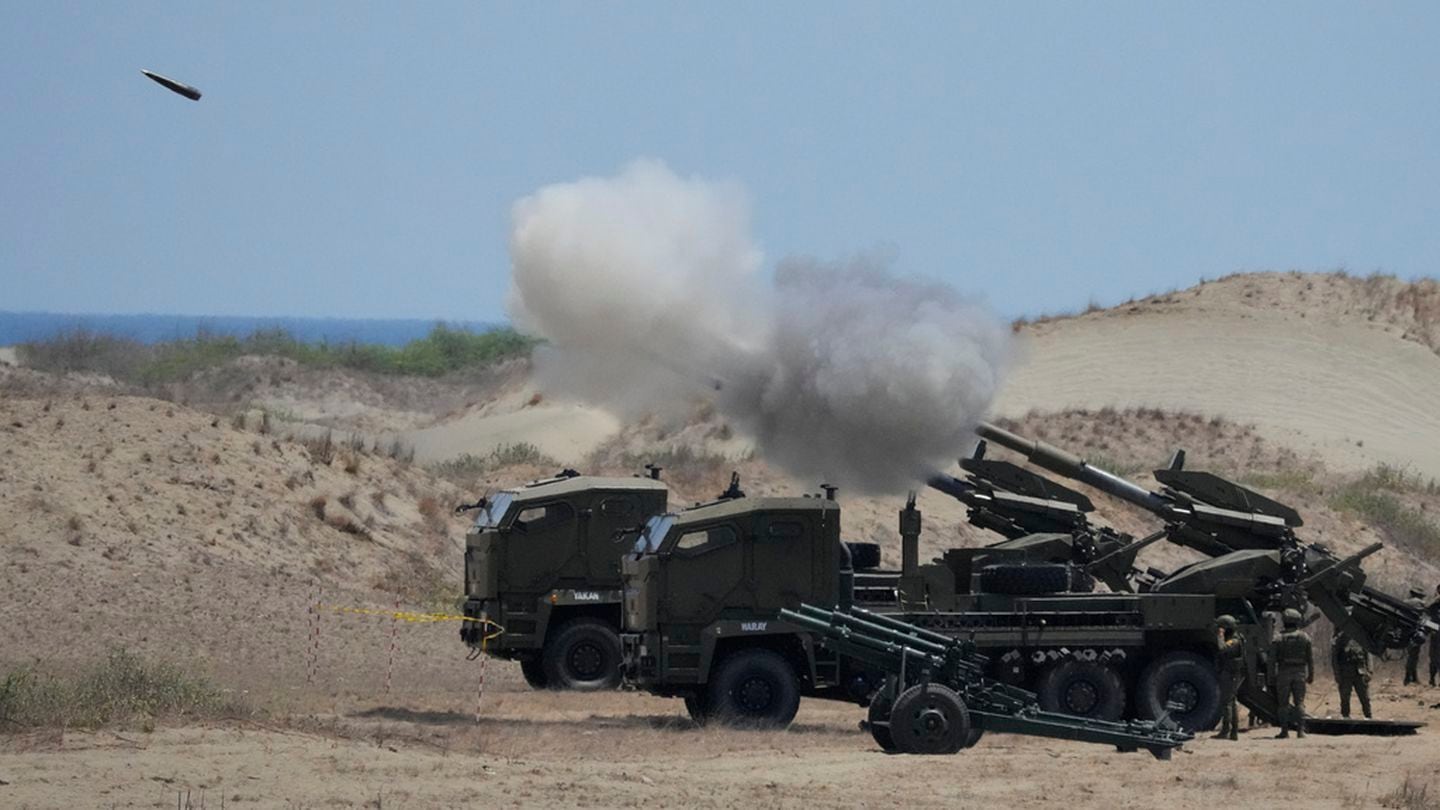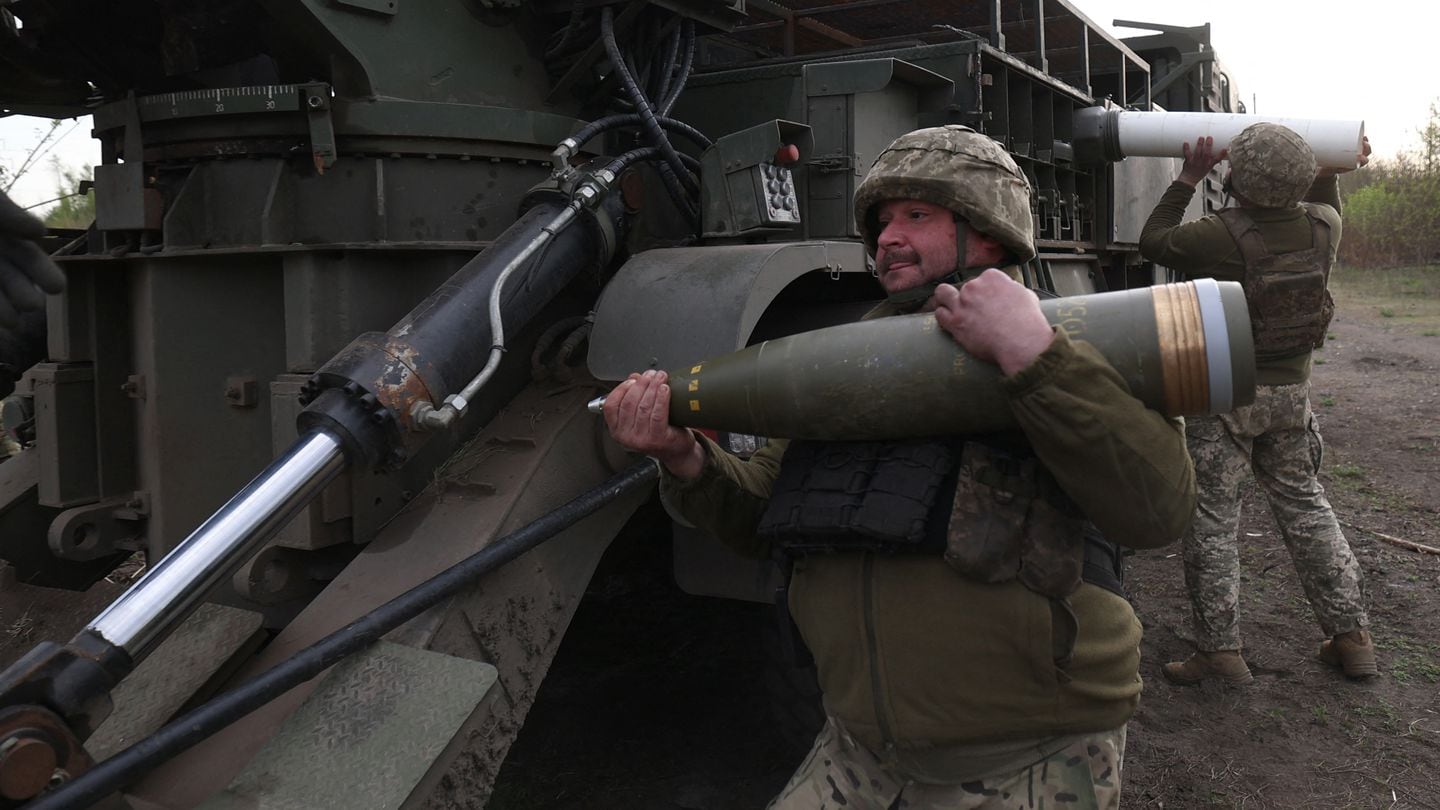PARIS — French artillery engineers had a simple idea: Take a big gun, mount it on a truck, and you’ve got self-propelled artillery at relatively little cost. The wheeled guns have proved so effective on the Ukrainian battlefield that Western armies are taking a fresh look at the concept.
The war in Ukraine has put long-range fires front and center at the Eurosatory defense show that kicks off in Paris, France, on June 17, said Charles Beaudouin, the retired French general who heads the event. As drones and rapid counter-battery fire have put a premium on artillery mobility for survival, he expects KNDS France’s truck-mounted Caesar howitzer to be one of the stars of the show.
“The audacity of the wheeled cannon is the maximum efficiency,” Beaudouin told Defense News. “You sacrifice nothing in terms of firepower, rate of fire, precision and range, and you’ve got a truck, armored all the same, but which is able to be nimble, which is very stealthy.”
Beaudouin was part of the French Army’s decision to buy an upgraded Caesar, so he might be suspected of bias toward wheels. But at least nine other countries, including the U.K. and Germany, decided to invest in self-propelled wheeled howitzers in the past year. Analysts said the Ukrainian experience is driving military planners’ interest.
“Ukraine is definitely shaping the towed versus wheeled discussion,” said Paul Daniels, a defense industry consultant and retired U.S. Army officer who attended the Future Artillery conference in Paris in May, during which he said there has been “an uptick in focus on wheeled, self-propelled howitzers.”
Battlefield threats to artillery now include loitering munitions and precision-guided shells, said Elbit Systems, which makes the Atmos truck-mounted howitzer. The war in Ukraine has highlighted a “critical need” for mobility, the Israeli firm wrote in an email to Defense News.
Systems such as the Caesar and Atmos can pull into position, fire multiple rounds and race off in a matter of minutes — a tactic known in military parlance as “shoot and scoot.”

Finland’s Patria is aiming to fit its 155mm towed artillery piece on a wheeled chassis in response to combat observations in Ukraine, the Finnish newspaper Aamulehti reported in April.
KNDS is seeing “a lot more interest” in Caesar, amplified by leaks from Russian soldiers indicating the weapon is particularly feared, according to spokesman Guillem Monsonis. Russian military bloggers on Telegram in April described the Caesar’s range, accuracy and mobility, saying the system killed numerous Russian artillerymen with counter-battery fire.
The Caesar’s advantage is its agility, which doesn’t give Russian forces enough time to locate and target the Ukrainian crews, an artilleryman told French broadcaster TF1 last year.
Across the pond
Ubiquitous drone observation means gun crews in Ukraine have to camouflage their positions or scram immediately after firing to avoid retaliatory strikes.
The “absolute saturation” of sensors will make hiding near-impossible on the future battlefield, Gen. James Rainey, the chief of U.S. Army Futures Command, said in a May 15 Senate hearing.
Rainey previously said the future for towed artillery with the Army “is not bright,” and the service is looking at the European theater as it considers modernization. “There are some very good wheeled howitzers that are having great effect in a place like Europe where the road systems are pretty mature,” Rainey said.
The Army has said it needs more range, mobility and autonomy, and will ask companies this year to demonstrate in-production artillery systems for a competitive evaluation in fiscal 2025. The service tested the Caesar, the Atmos, BAE Systems’ Archer and Yugoimport’s Nora-B-52 in 2021.
The modern, European self-propelled systems have 155mm, 52-caliber barrels for a standard range of about 40 kilometers (25 miles). That outranges the U.S. Army’s towed M777 and the tracked M109A6 Paladin howitzers, as well as Russian tube artillery, though drones pose a threat to Ukrainian crews out of Russian gun range.

Elbit said the immediate need for artillery systems in light of the Ukrainian conflict caused customers to prioritize Atmos over other weapon systems. Meanwhile, KNDS said there are more and more wheeled systems on offer, and a lot more potential buyers.
Interest in wheeled self-propelled artillery flows from a desire for a “much higher degree of mobility and survivability” than towed guns, said Daniels. Military staff who see wheels as an attractive option over tracks “often define survivability in a broader way, as opposed to seeing it purely from the physical protection offered by onboard armor,” he added.
Eurosatory will feature at least 10 artillery makers; that’s more than in 2022. Cannon and rocket artillery will be major topics, with the M142 High Mobility Artillery Rocket System another centerpiece of the show, according to Beaudouin.
KNDS will premiere the six-wheeled Caesar MkII as well as display the eight-wheeled version of the cannon and the tracked Panzerhaubitze 2000. BAE Systems will show the M777 towed gun and a model of the Archer. Elbit had been planning to present its PULS multiple-rocket launcher and the Sigma next-generation howitzer, both wheeled, before the French government banned Israeli vendors from Eurosatory in late May over the Israeli military’s conduct in its war against Hamas in Gaza.

The Caesar prototype presented at Eurosatory in 1994 was a departure from the tracked and armored behemoths en vogue with many Western armies during the Cold War.
“Before the conflict in Ukraine, many gunners around the world thought that for high-intensity warfare, the only serious guns would be tracked armor,” said Monsonis, the KNDS spokesman. “The conflict in Ukraine has shown that, on the contrary, the Caesar is not only perfectly suited to high-intensity warfare but also fares better than other types of gun.”
Around 10% of Caesars in Ukraine had been destroyed by March, compared with almost a third of the tracked 52-caliber armored guns, according to the manufacturer.
Global trend
Truck-mounted systems have gained in popularity in recent years, with the Turkish firm Asfat working on the Arpan 155 for the country’s army and the China North Industries Group Corp. in February unveiling a turreted truck-mounted howitzer.
The past six months hosted a flurry of wheeled-artillery purchases, include Belgium with the Caesar MkII, Brazil picking Atmos, and the U.K. and Germany announcing plans in April to acquire KNDS Deutschland’s RCH 155 based on the eight-wheeled Boxer.
Mobility has been key for governments turning to wheels. Belgium’s Defence Ministry said buying the Caesar was an investment in “exceptional mobility,” while Estonian Defence Minister Hanno Pevkur told local daily Postimees that the country plans to buy the wheeled cannons to add fast and flexible long-range fires to its fleet of “not very maneuverable” tracked K9 howitzers, made in South Korea.
With a host of technology flying over the battlefield, including loitering munitions, “the game today is not to be spotted, and that’s where Caesar has a huge advantage,” Pierre-André Moreau, a former senior weapons engineer for the French Army and the brains behind the truck-mounted howitzer, said in an interview last year with YouTube channel VA Plus. He said ubiquitous anti-tank munitions and drones on the battlefield mean armored artillery “is on the verge of becoming totally obsolete.”
France, Denmark and Ukraine agreed in March to finance 78 additional Caesar systems for Ukraine in 2024, adding to 49 systems already delivered. KNDS by early April was producing six of the howitzers per month, up from a rate of two before the war, with a target for 12 cannons per month.
Meanwhile, Ukraine has accelerated production of its homegrown wheeled howitzer Bohdana to 10 systems per month, President Volodymyr Zelenskyy said in April.

Russia joined the trend last year with the Malva wheeled howitzer, breaking with a tradition of tracked self-propelled artillery. State-owned manufacturer Rostec highlighted the greater maneuverability, making a link between better mobility and saving Russian forces’ lives. The range of the 152mm cannon may still leave the gun vulnerable to Ukraine’s longer-reaching systems.
The lower cost of wheels over tracks will matter for countries seeking to build up their artillery force, Beaudouin said. France agreed to buy 109 Caesar MkII weapons at the end of 2023 for a unit cost of €3.2 million (U.S. $3.5 million), compared with Germany buying 10 tracked Panzerhaubitze 2000s in March 2023 for €18.4 million (U.S. $20 million) apiece.
Operating and maintaining wheeled systems also tends to be cheaper, with studies from the U.S. and Europe indicating cost savings of roughly 30%.
The six-wheel Caesar and Atmos models are flyweights compared with their armored and tracked brethren, which explains their mobility and lower operating costs. The French gun comes in at less than 18 tons, and its Israeli rival at about 20 tons, compared with 57 tons for the Panzerhaubitze and 47 tons for the K9.
The turret on the RCH 155 adds bulk as well, pushing the weight to 39 tons. Tactical mobility for wheeled systems drops once loads exceed 8 tons per axle, according to Beaudouin, who said the Boxer chassis struggles under the weight of a gun turret.
The widespread use of wheeled artillery in Ukraine was dictated by availability rather than a tactical choice, said Spencer Jones, a senior lecturer in war studies at the U.K.-based University of Wolverhampton. In the end, the weapons worked well in a war characterized by intense counter-battery fire.
“Ukrainian use of shoot-and-scoot artillery fire suggests that the future lies in highly mobile artillery, be they tracked or wheeled,” Jones said.
from Defense News https://ift.tt/1t7aVwq
via IFTTT

Post a Comment